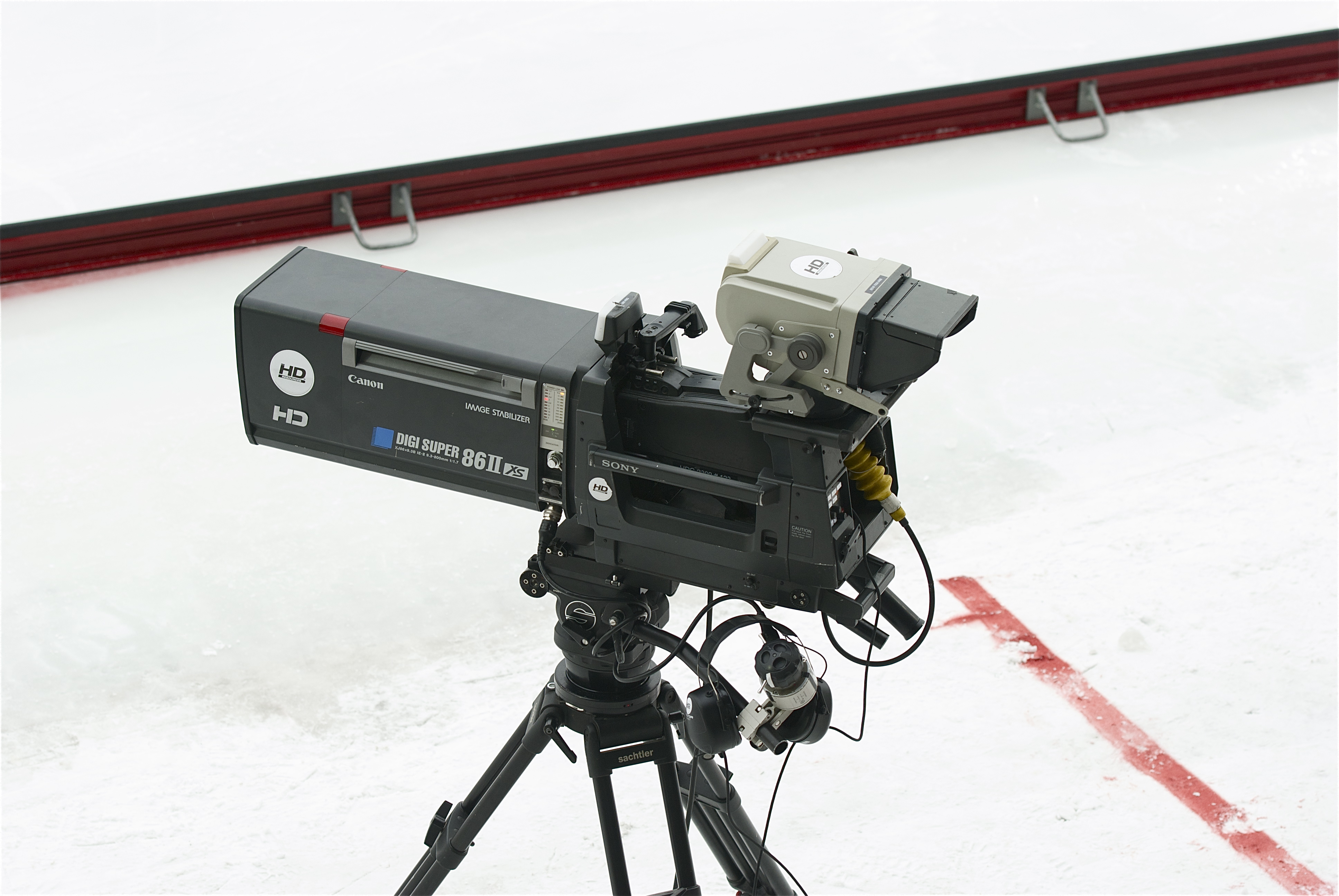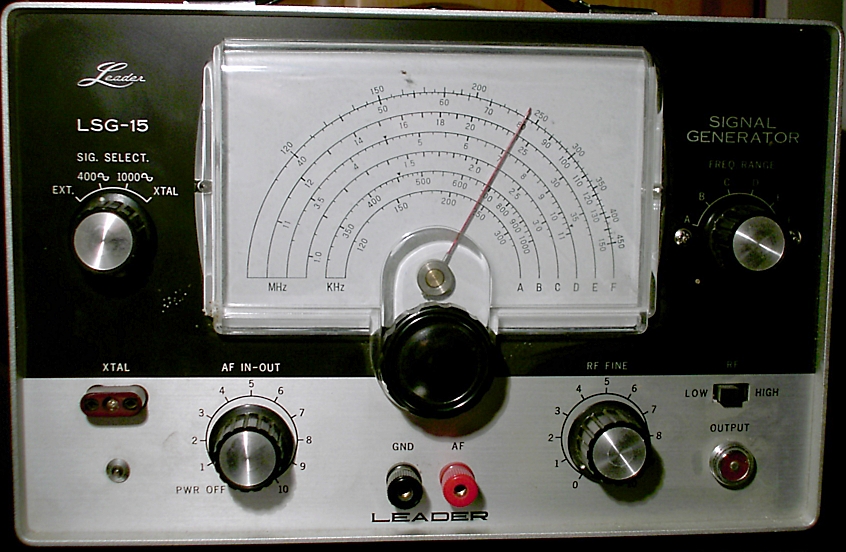|
Genlock
Genlock (generator locking) is a common technique where the video output of one source (or a specific reference signal from a signal generator) is used to synchronize other picture sources together. The aim in video applications is to ensure the coincidence of signals in time at a combining or switching point. When video instruments are synchronized in this way, they are said to be ''generator-locked'', or ''genlocked''. Possible problems Video signals generated and output by generator-locked instruments are said to be syntonized. Syntonized video signals will be precisely frequency-locked, but because of delays caused by the unequal transmission path lengths, the synchronized signals will exhibit differing phases at various points in the television system. Modern video equipment such as production switchers that have multiple video inputs often include a variable delay on each input to compensate for the phase differences and time all the input signals to precise phase coinc ... [...More Info...] [...Related Items...] OR: [Wikipedia] [Google] [Baidu] |
Time Base Corrector
Time base correction (TBC) is a technique to reduce or eliminate errors caused by mechanical instability present in analog recordings on mechanical media. Without time base correction, a signal from a videotape recorder (VTR) or videocassette recorder (VCR), cannot be mixed with other, more time-stable devices such as character generators and video cameras found in television studios and post-production facilities. Time base correction counteracts errors by buffering the video signal as it comes off the videotape at an unsteady rate, and releasing it after a delay at a steady rate. A sync generator provides the timing reference for all devices in the system. By adjusting the delay using a waveform monitor, the corrected signal can be made to match the timing of the other devices in the system. If all of the devices in a system are adjusted so their signals meet the video switcher at the same time and at the same rate, the signals can be mixed. Though external TBCs are often us ... [...More Info...] [...Related Items...] OR: [Wikipedia] [Google] [Baidu] |
Frame Synchronizer (video)
Time base correction (TBC) is a technique to reduce or eliminate errors caused by mechanical instability present in analog recordings on mechanical media. Without time base correction, a signal from a videotape recorder (VTR) or videocassette recorder (VCR), cannot be mixed with other, more time-stable devices such as character generators and video cameras found in television studios and post-production facilities. Time base correction counteracts errors by buffering the video signal as it comes off the videotape at an unsteady rate, and releasing it after a delay at a steady rate. A sync generator provides the timing reference for all devices in the system. By adjusting the delay using a waveform monitor, the corrected signal can be made to match the timing of the other devices in the system. If all of the devices in a system are adjusted so their signals meet the video switcher at the same time and at the same rate, the signals can be mixed. Though external TBCs are often ... [...More Info...] [...Related Items...] OR: [Wikipedia] [Google] [Baidu] |
Television Camera
A professional video camera (often called a television camera even though its use has spread beyond television) is a high-end device for creating electronic moving images (as opposed to a movie camera, that earlier recorded the images on filmstock, film). Originally developed for use in television studios or with Outside broadcasting, outside broadcast Production truck, trucks, they are now also used for music videos, direct-to-video movies (see digital movie camera), corporate and educational videos, wedding videos, among other uses. Since the 2000s, most professional video cameras are digital (instead of analog). The distinction between professional video cameras and movie cameras narrowed as HD digital video cameras with sensors the same size as 35mm movie cameras - plus Dynamic range#Photography, dynamic range (exposure latitude) and color rendition approaching film quality - were introduced in the late 2010s. Nowadays, HDTV cameras designed for broadcast television, news, sp ... [...More Info...] [...Related Items...] OR: [Wikipedia] [Google] [Baidu] |
Tri-level Sync
Tri-level sync is an analogue video synchronization pulse primarily used for the locking of high-definition video signals ( genlock). It is preferred in HD environments over black and burst, as timing jitter is reduced due to the nature of its higher frequency. It also benefits from having no DC content, as the pulses are in both polarities. Synchronization Modern real-time multi-source HD facilities have many pieces of equipment that all output HD- SDI video. If this baseband video is to be mixed, switched or luma keyed with any other sources, then they will need to be synchronous, i.e. the first pixel of the first line must be transmitted at the same time (within a few microseconds). This then allows the switcher A switcher locomotive (American English), shunter locomotive (British English), station pilot (British English), or shifter locomotive (Pennsylvania Railroad terminology) is a locomotive used for maneuvering railway vehicles over short distanc ... to cut, mix ... [...More Info...] [...Related Items...] OR: [Wikipedia] [Google] [Baidu] |
Vision Mixer
A vision mixer is a device used to select between different live video sources and, in some cases, compositing live video sources together to create visual effects. In most of the world, both the equipment and its operator are called a vision mixer or video mixer; however, in the United States, the equipment is called a video switcher, production switcher or video production switcher, and its operator is known as a technical director. The role of the vision mixer for video is similar to what a mixing console does for audio. Typically a vision mixer would be found in a video production environment such as a production control room of a television studio, production truck or post-production facility. Capabilities and usage Besides hard cuts (switching directly between two input signals), mixers can also generate a variety of other transitions, from simple dissolves to pattern wipes. Additionally, most vision mixers can perform keying operations (called mattes in thi ... [...More Info...] [...Related Items...] OR: [Wikipedia] [Google] [Baidu] |
Colorburst
Colorburst is an analog and composite video signal generated by a video-signal generator used to keep the chrominance subcarrier synchronized in a color television signal. By synchronizing an oscillator with the colorburst at the back porch (beginning) of each scan line, a television receiver is able to restore the suppressed carrier of the chrominance (color) signals, and in turn decode the color information. The most common use of colorburst is to genlock equipment together as a common reference with a vision mixer in a television studio using a multi-camera setup. Explanation In NTSC, its frequency is exactly 315/88 = 3.579 MHz with a phase of 180°. PAL uses a frequency of exactly 4.43361875 MHz, with its phase alternating between 135° and 225° from line to line. Since the colorburst signal has a known amplitude, it is sometimes used as a reference level when compensating for amplitude variations in the overall signal. SECAM is unique in not ... [...More Info...] [...Related Items...] OR: [Wikipedia] [Google] [Baidu] |
Signal Generator
A signal generator is one of a class of Electronics, electronic devices that generates electrical signals with set properties of amplitude, frequency, and wave shape. These generated signals are used as a stimulus for electronic measurements, typically used in designing, testing, troubleshooting, and repairing electronic or electroacoustic devices, though it often has artistic uses as well. There are many different types of signal generators with different purposes and applications and at varying levels of expense. These types include function generators, RF and microwave signal generators, pitch generators, arbitrary waveform generators, digital pattern generators, and frequency generators. In general, no device is suitable for all possible applications. A signal generator may be as simple as an oscillator with calibrated frequency and amplitude. More general-purpose signal generators allow control of all the characteristics of a signal. Modern general-purpose signal generato ... [...More Info...] [...Related Items...] OR: [Wikipedia] [Google] [Baidu] |
Film And Video Technology
A film, also known as a movie or motion picture, is a work of visual art that simulates experiences and otherwise communicates ideas, stories, perceptions, emotions, or atmosphere through the use of moving images that are generally, since the 1930s, synchronized with sound and (less commonly) other sensory stimulations. Etymology and alternative terms The name "film" originally referred to the thin layer of photochemical emulsion on the celluloid strip that used to be the actual medium for recording and displaying motion pictures. Many other terms exist for an individual motion-picture, including "picture", "picture show", "moving picture", "photoplay", and "flick". The most common term in the United States is "movie", while in Europe, "film" is preferred. Archaic terms include "animated pictures" and "animated photography". "Flick" is, in general a slang term, first recorded in 1926. It originates in the verb flicker, owing to the flickering appearance of early films. ... [...More Info...] [...Related Items...] OR: [Wikipedia] [Google] [Baidu] |
Synchronization
Synchronization is the coordination of events to operate a system in unison. For example, the Conductor (music), conductor of an orchestra keeps the orchestra synchronized or ''in time''. Systems that operate with all parts in synchrony are said to be synchronous or ''in sync''—and those that are not are ''Asynchronous system, asynchronous''. Today, time synchronization can occur between systems around the world through satellite navigation signals and other time and frequency transfer techniques. Navigation and railways Time-keeping and synchronization of clocks is a critical problem in long-distance ocean navigation. Before radio navigation and Radionavigation-satellite service, satellite-based navigation, navigators required accurate time in conjunction with astronomical observations to determine History of longitude, how far east or west their vessel traveled. The invention of an accurate marine chronometer revolutionized marine navigation. By the end of the 19th cent ... [...More Info...] [...Related Items...] OR: [Wikipedia] [Google] [Baidu] |
Vertical Blanking Interval
In a raster scan display, the vertical blanking interval (VBI), also known as the vertical interval or VBLANK, is the time between the end of the final visible line of a frame or field and the beginning of the first visible line of the next frame or field. It is present in analog television, VGA, DVI and other signals. Here the term field is used in interlaced video, and the term frame is used in progressive video and there can be a VBI after each frame or field. In interlaced video a frame is made up of 2 fields. Sometimes in interlaced video a field is called a frame which can lead to confusion. In raster cathode-ray tube (CRT) displays, the blank level is usually supplied during this period to avoid painting the retrace line—see raster scan for details; signal sources such as television broadcasts do not supply image information during the blanking period. Digital displays usually will not display incoming data stream during the blanking interval even if present. The ... [...More Info...] [...Related Items...] OR: [Wikipedia] [Google] [Baidu] |
Electronic News Gathering
Electronic news gathering (ENG) or electronic journalism (EJ) is usage of electronic video and audio technologies by reporters to gather and present news instead of using film cameras. The term was coined during the rise of videotape technology in the 1970s. ENG can involve anything from a single reporter with a single professional video camera, to an entire television crew taking a truck on location. Beginnings Shortcomings of film The term ENG was created as television news departments moved from film-based news gathering to electronic field production technology in the 1970s. Since film requires chemical processing before it can be viewed and edited, it generally took at least an hour from the time the film arrived back at the television station or network news department until it was ready to be broadcast. Film editing was done by hand on what was known as " color reversal" film, usually Kodak Ektachrome, meaning there were no negatives. Color reversal film had repla ... [...More Info...] [...Related Items...] OR: [Wikipedia] [Google] [Baidu] |









